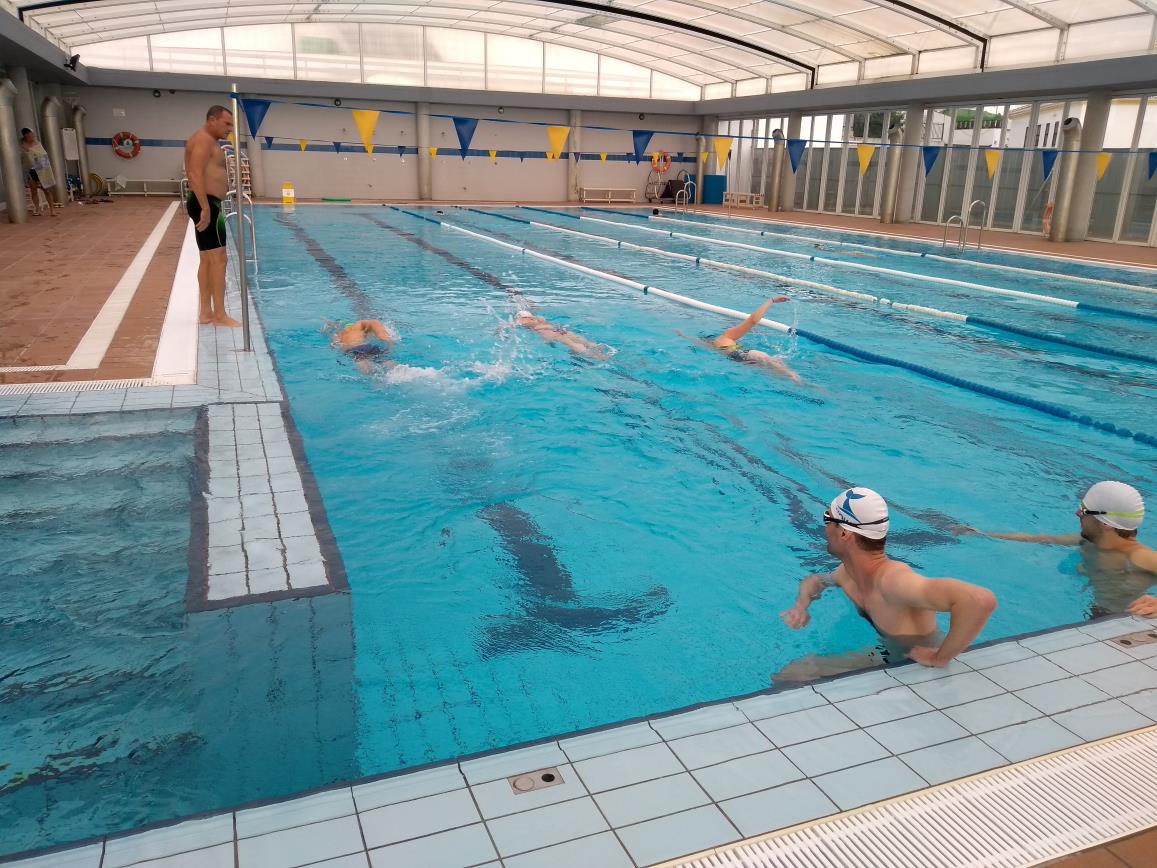How to complete a Swimming Time Trial (TT) and Swim Pacing Guidance (CSS)
 Karen Parnell
September 17, 2024
Karen Parnell
September 17, 2024
Swimming camp at ChiliTri using the pool in Competa
How to complete a Swimming Time Trial (TT) and Swim Pacing Guidance (CSS)
The words “time trial” can make even the most experienced triathlete or swimmer shudder but they are extremely valuable. They are not a test you pass or fail so it´s best just to relax into it and just do the best you can on the day. There is no right or wrong. I like them because they put a stake in the ground for your current fitness. You can set goals based on your fitness rather than some obscure number you got from a magazine or a friend. Once you've set your goals, it's time to think about workouts that help move you toward your race goals and swim leg target times.
After a few weeks of training, you can do the time trial again to see if your strategy led to the improvement, you were looking for.
I do understand that some athletes dislike the thought of time trials. Some of these athletes get performance anxiety and time trials are a way to help them work through the nerves that come with a test. Other athletes may just be terrible testers but great racers. For these athletes it may be best to use races as benchmark time trials for the non-aerobic tests.
The Time Trial will all help you calculate your Critial Swim Speed (CSS) or Threshold pace which will help you with your swim training.
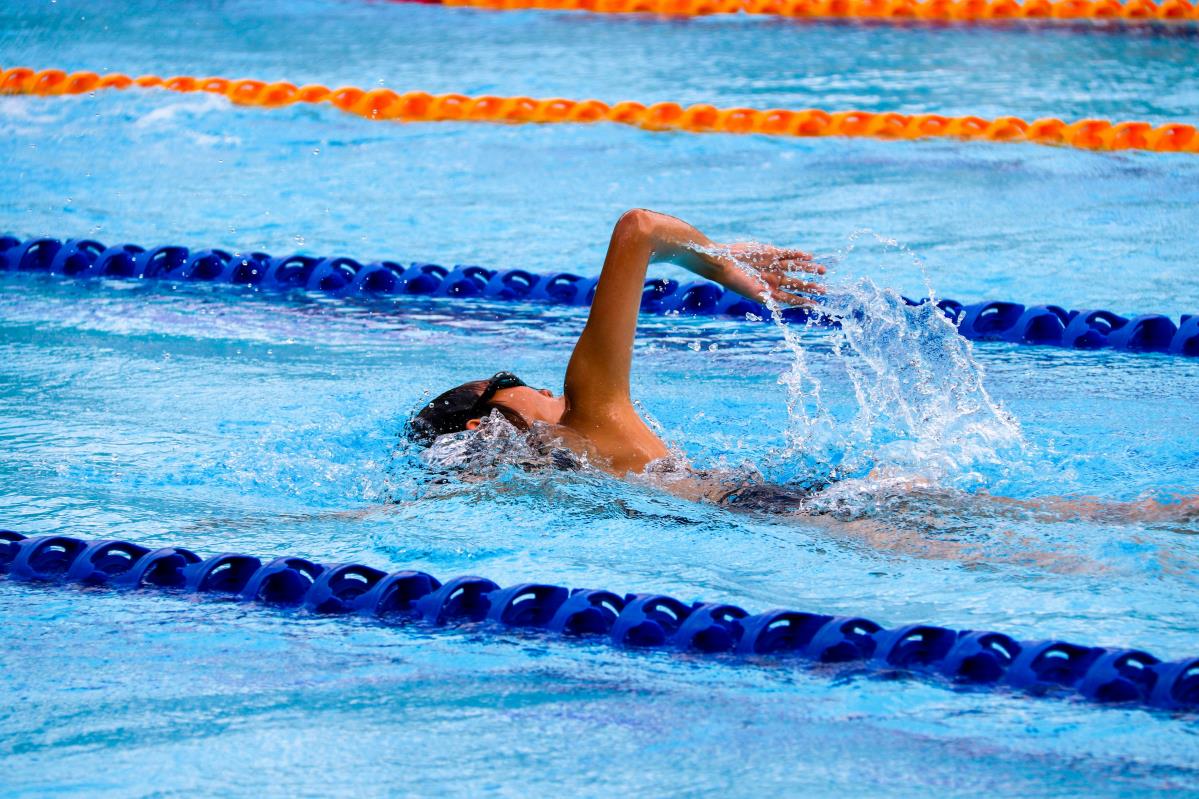
Get your FREE swimming workouts and tips book here.
What is CSS and why is it useful?
Critical Swim Speed (CSS) is defined as the theoretical fastest pace that a swimmer can maintain continuously without exhaustion, your aerobic swimming threshold. Your CSS is computed using your time for a 400 m or yard time trial, and your time for a 200 m or yard time trial.
CSS is a pace that’s tough enough to develop your aerobic capacity but not so hard that it’ll take you days to recover. So you can improve your swim fitness and still have enough energy to go running or cycling (or swimming again).
CSS is a race-specific training pace. It may not make you the fastest 50 or 100 swimmer, but it will train you to sustain a moderately high speed for longer distances which is ideal for triathlons.
CSS training teaches you about pace awareness the hard way (which is usually the best way) Go off too fast and you’ll pay the price later. Thankfully you can test your current CSS pace without having to swim a solo 1500 Time Trial. See below for instructions.
Once you know your CSS pace, you can use a Finis Tempo Trainer Pro to help you train. It’s a small beeping device that attaches to your goggles. Dial in your CSS pace and it’ll happily beep every lap so that you can maintain perfect pace.
To test your current CSS pace, you need to swim a 400 and 200 Time Trial within the same session. Ideally, get a friend or coach to time you and record your 50 splits and strokes per minute (SPM). Failing that, simply record the 400 and 200 times yourself. Once you have completed the TT, enter your 400 and 200 times into the ChiliTri swim calculator.

Using a waterproof phone as a stop watch for your CSS test Photo by Castorly Stock
Get your FREE swimming workouts and tips for triathletes book here.
The Time Trail Session
Here's how you conduct a CSS Time Trial. The warm up is quite long to ensure you are fully ready for your test swim.
It's best to do this with a buddy or coach so they can record your times for the 400 and 200. You can then enter these times into the ChiliTri CSS calculator so you know your swimming pace zones.
You will need a stopwatch, something to note your times down on and preferrably a friend to help time you. You get extra coach points if you have a clip board!
The Swim Time Trail Test Set
Warm Up
300 easy freestyle as 200 fins as 50 choice drill, 50 freestyle
4 x 50 freestyle (25 fast + 25 easy) +10 seconds rest then
4 x 100 freestyle (20 seconds rests)
Do these 100’s at what you perceive to be the AVERAGE pace that you can sustain for a 400 Time Trial.
Main Set
Swim your 400-time trial as a continuous 400 swim and remember there is no right or wrong!
Take 5 to 8 minutes easy swimming/stretching. Feel fully recovered, then:
Swim your 200-time trial as a continuous 200 swim
Write down your 400m, 200m and time for the first 100m of your 400.
Warm Down
100 easy choice of stroke (it´s nice to throw in a few lengths of back stroke to relax off your shoulders and chest. Stretch well pool side after.
Plug your results into the ChiliTri CSS calculator to find your Critical Swim Speed (CSS).
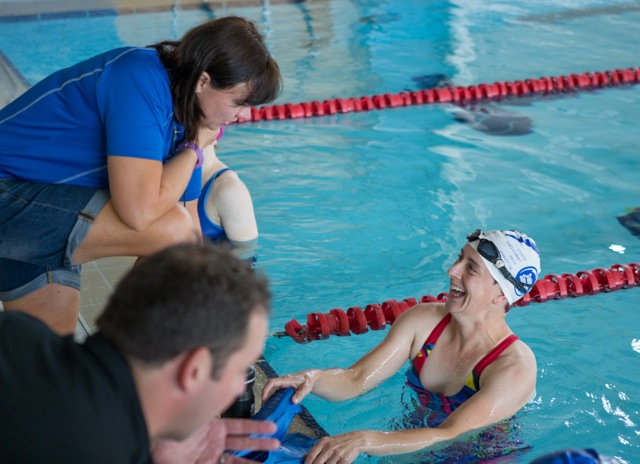
Coach Karen giving feedback to a happy swimmer
Get your FREE Open Water Swimming Sessions E-Book
Get your FREE swimming workouts and tips book here.
CSS Sample Workout
CSS: 'Critical Swim Speed' - this pace (for swimming) is comparable to 'threshold' speed on the bike or run. It's a good marker for a pace to aim for during your repeats. This pace will be worked out after undertaking a 'CSS test' as detailed above.
It is expressed as pace per 100m, so a CSS pace might be 1.40 (1 minute 40 seconds per 100m)
Sometimes pace guidance will be given like this, in terms of ‘how the swim pace feels’ :
Easy: CSS +12s
Steady: CSS + 8s
Moderate: CSS + 4s
Hard: CSS pace
Fast / Very Hard: CSS - 4s
'CSS+4' means 'CSS pace plus 4 seconds per 100m.'
If your CSS pace was 1.40, CSS+4 would be 1.44 per 100m
Once you know your CSS pace, you can use a Finis Tempo Trainer Pro to help you train. It's a small beeping device (it used to be called a Wetronome) that attaches to your goggles or under your stuffed under your swimming hat because if you are like me you lose the clip! Enter in your CSS pace and it will beep every lap so that you can maintain the pace you require foe that session.
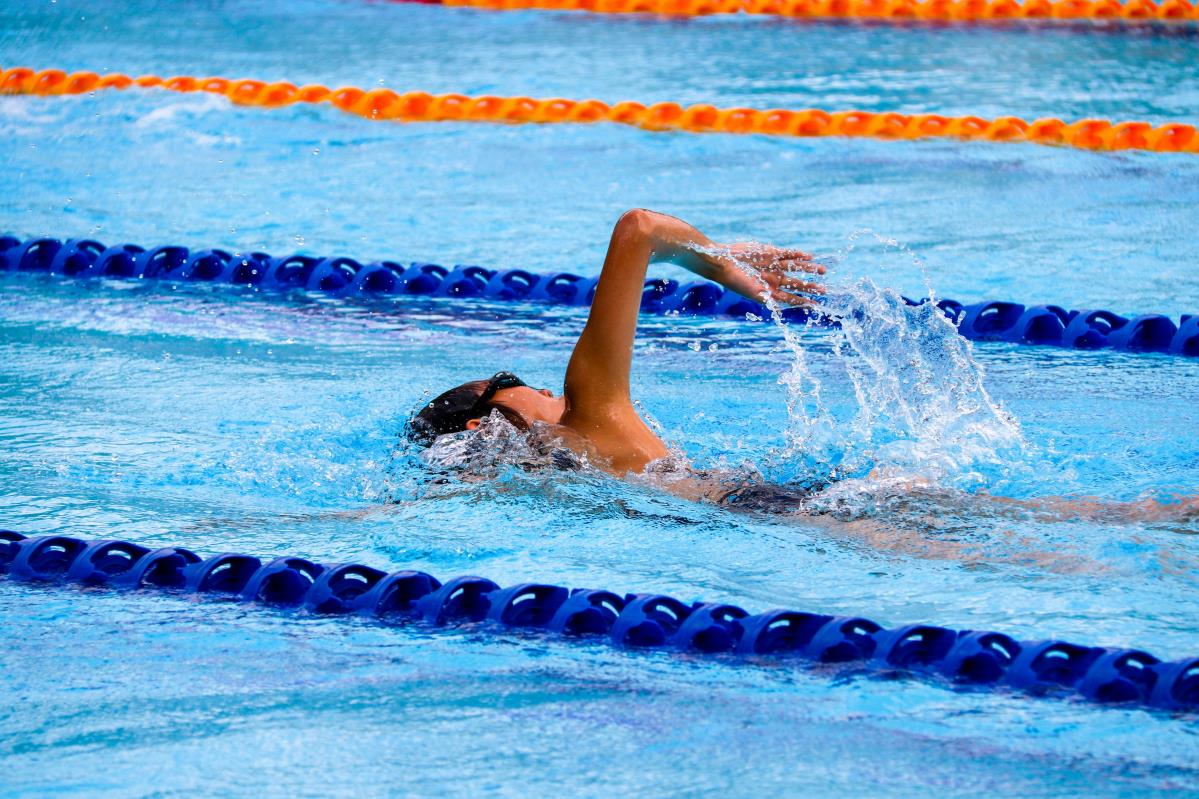
Photo by Marcus Ng
Get your FREE swim workouts for Open Water E-Book
Example CSS based workout: Endurance and Pace Awareness
Session Goals: Improve swim endurance and speed plus enhance your pace awareness at your CSS
Warm-Up (15 minutes)
200m Easy Swim: Focus on relaxed strokes and breathing.
4 x 50m Drill: Alternate between:
- Catch-up drill
- 6-1-6 drill
Rest 15 seconds between each.
100m Build: Gradually increase your pace throughout.
Main Set (30 minutes)
Set you Tempo Trainer to you CSS pace from your CSS TT.
3 x 300m at CSS Pace:
Aim for consistent times; rest 30 seconds between each.
4 x 100m at 90% Effort:
Focus on speed and form; rest 15 seconds between each.
Warm Down (10 minutes)
200m Easy Swim: Relax and focus on long strokes.
100m Backstroke or Breaststroke: to promote recovery.
This session is designed to build your endurance while honing your pacing skills at your CSS. Let me know waht you think.
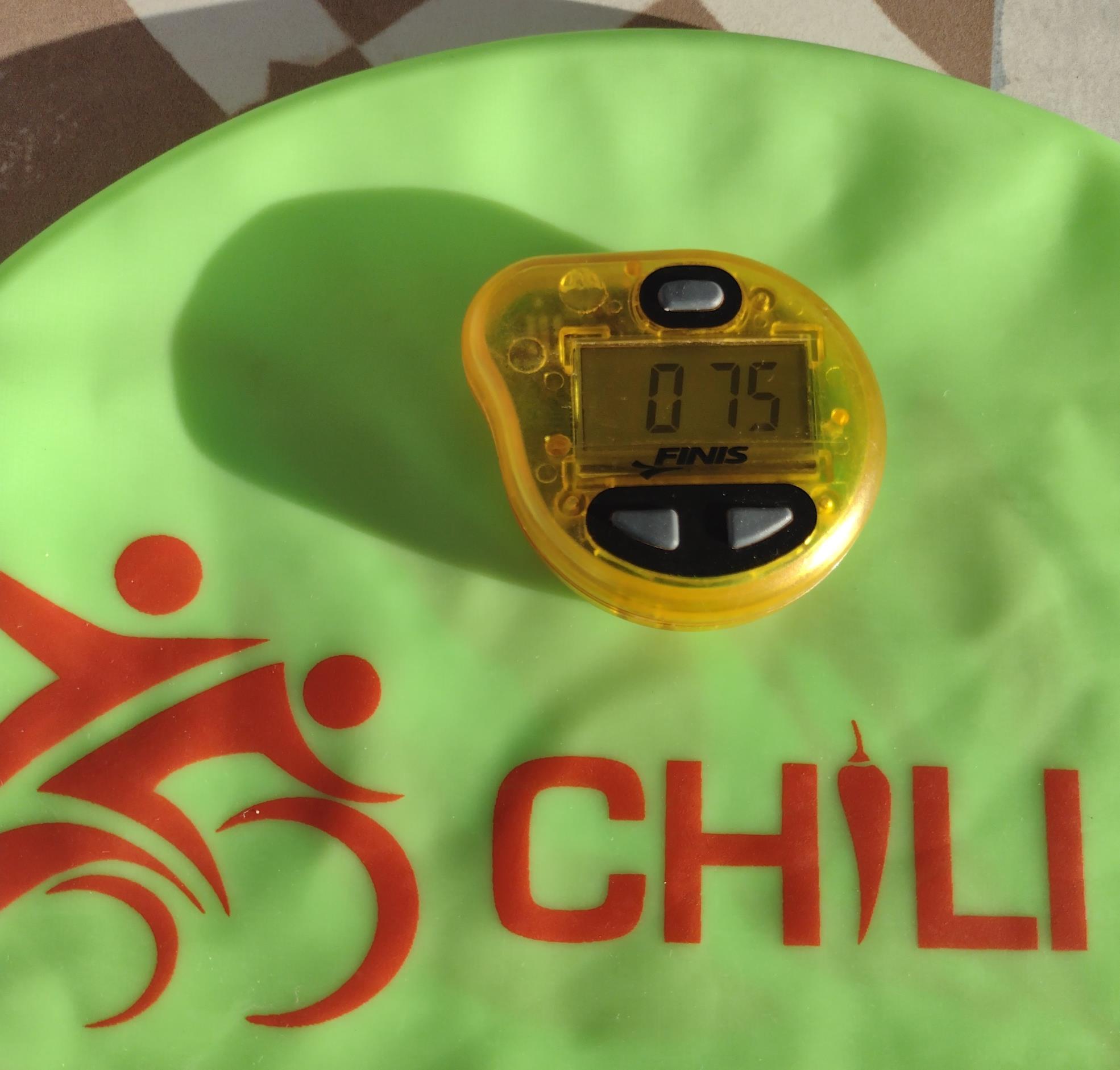
The Finis Tempo Trainer beging used at ChiliTri
Get your FREE swimming workouts and tips book here.
Using CSS in your Swim Training
Including CSS based swimming sessions into your triathlon training can help you improve the speed you can sustain over your race distance and also develop your pace judgement. In addition to CSS training, it's also important to include various different swimming sessions such as speed, threshold and endurance workouts in order to meet the needs of your target races. Technique work including drills and open water training are also important.
If you prefer Heart Rate or RPE here's how it relates to CSS:
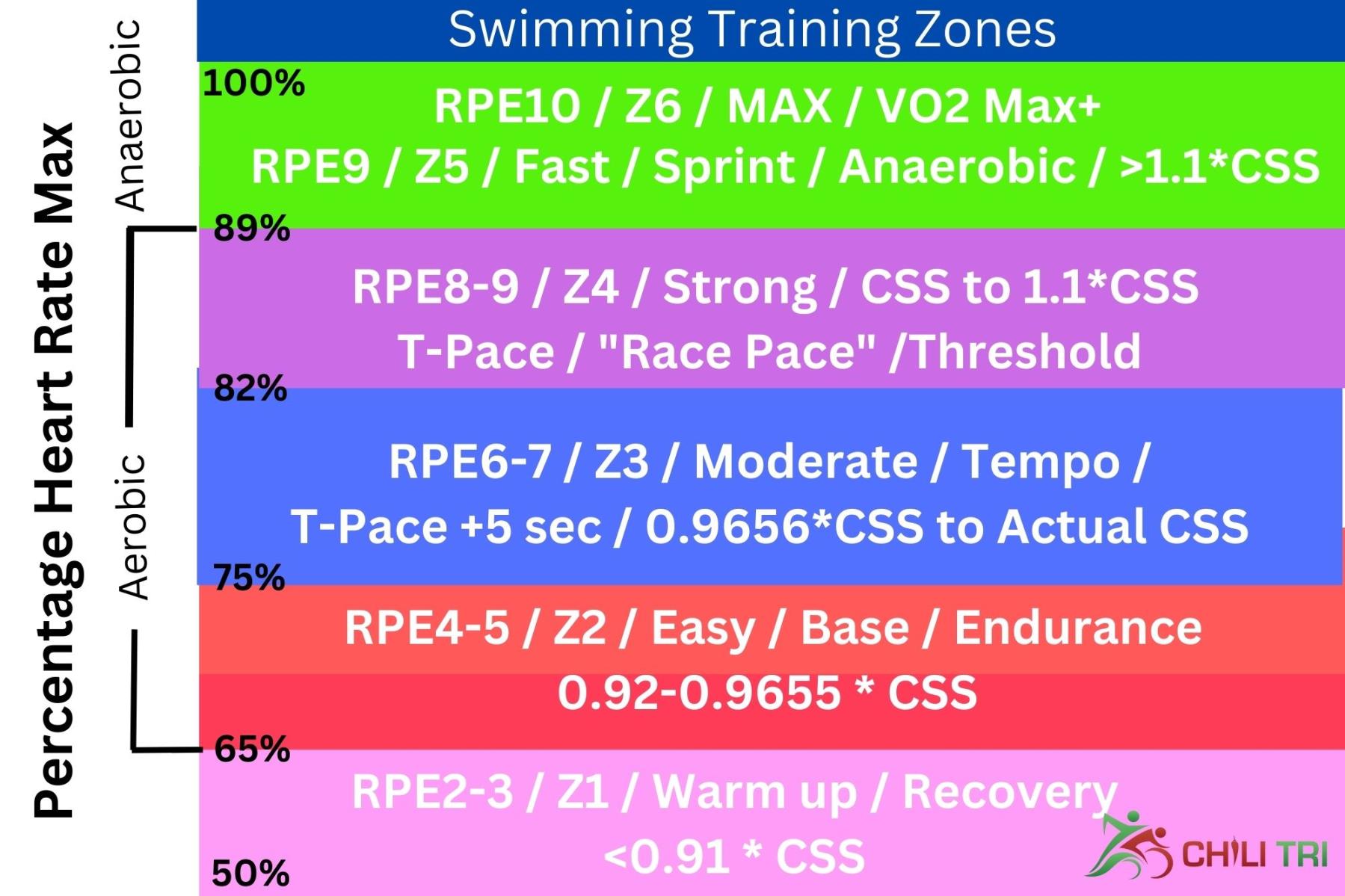
Here’s a FREE Swim Workouts for Triathletes Book with swim workouts, tips, technique, drills, kit and terms.
Would you like a free training plan? Claim your free plan or e-book.
Conclusion: Benefits of Completing a Swim Time Trial
Competing a swimming time trial (TT) regularly will help you understand your improvements and also get you used to swimming at your race pace. The TT test will also enable you to calculate your Critical Swim Speed (CSS).
Incorporating Critical Swim Speed (CSS) into your training regimen is a game changer for any swimmer or triathlete.
By understanding how to determine your CSS through time trials and utilizing tools like the Tempo Trainer Pro, you can fine-tune your pacing and improve your efficiency in the water. The example swim session provided offers a practical application of your CSS, allowing you to enhance both your endurance and speed.
Moreover, relating your CSS to heart rate can give you valuable insights into your effort levels, helping you manage your intensity during training and races. As you continue to integrate these concepts into your workouts, you’ll find yourself swimming faster and more efficiently, setting you up for success on race day.
Keep swimming smart and enjoy the journey to reaching your goals!
Karen Parnell is a Level 3 British Triathlon and IRONMAN Certified Coach, 8020 Endurance Certified Coach, WOWSA Level 3 open water swimming coach and NASM Personal Trainer and Sports Technology Writer.
Karen is currently studying for an MSc in Sports Performance Coaching at the University of Stirling.
Need a training plan? I have plans on TrainingPeaks and FinalSurge:
I also coach a very small number of athletes one to one for all triathlon and multi-sport distances, open water swimming events and running races, email me for details and availability. Karen.parnell@chilitri.com
Get your FREE Swim Workouts for Triathletes E-book
Get your FREE Open Water Swimming Workouts E-Book
FAQ - Critical Swim Speed (CSS) and Swimming Time Trials (TT)
What is a swimming time trial?
A swimming time trial is a timed swim over a set distance, performed under race-like conditions but without direct competition. It helps swimmers gauge their performance and progress.
Why should I complete a swimming time trial?
Time trials provide a benchmark for measuring improvement, help set realistic goals and simulate race conditions to build mental and physical endurance.
How can a time trial improve my training?
It helps identify strengths and weaknesses, refine pacing strategies, and track fitness levels over time. Coaches can also use time trial data to adjust training plans.
How often should I do a time trial?
Depending on your training cycle, doing a time trial every 4–6 weeks can be beneficial. This frequency allows for meaningful progress tracking without causing excessive fatigue.
Should I prepare differently for a time trial than for a regular workout?
Yes! Treat it like a race—ensure proper warm-up, focus on technique, and manage effort levels strategically to get the most accurate time.
Can time trials help with race day nerves?
Absolutely! Simulating race conditions in a time trial helps swimmers build confidence, improve focus, and reduce anxiety before an actual competition.
Do I need a coach or official to run a time trial?
Not necessarily but having a coach or experienced swimmer time your effort can provide more accurate results and feedback.
What is Critical Swim Speed (CSS)?
Critical Swim Speed (CSS) is a term used in swimming to describe the speed at which a swimmer can sustainably swim without experiencing significant fatigue for a prolonged period.
How is CSS determined?
CSS is typically determined through a swim test that involves swimming multiple distances at varying intensities. The times for these distances are then used to calculate the swimmer's CSS.
What are the units of CSS?
CSS is usually expressed in meters per second (m/s) or minutes per 100 meters (min/100m).
What is the significance of CSS?
CSS is an important parameter for swimmers as it helps in setting training intensities and planning workouts. It provides a benchmark for determining the appropriate pace for different types of training sets.
How is CSS used in training?
CSS is used to define training zones based on different percentages of the CSS pace. These zones help swimmers target specific energy systems and improve their endurance and speed.
Can CSS be used for all swimmers?
CSS is most applicable to intermediate and advanced swimmers who have a good level of cardiovascular fitness. Novice swimmers or those with limited swimming experience may find it challenging to accurately determine their CSS.
How often should CSS be retested?
CSS testing should be done periodically to track progress and make necessary adjustments to training zones. It is recommended to retest every 8-12 weeks or after significant improvements in performance.
Are there any limitations to CSS?
CSS is primarily a measure of aerobic capacity and endurance. It may not accurately reflect a swimmer's performance in sprint events or races that require different energy systems.
Can CSS be improved?
Yes, CSS can be improved through targeted training. By incorporating specific workouts that focus on endurance and speed, swimmers can gradually increase their CSS over time.
Should CSS be used as the sole measure of swimming performance?
While CSS is a valuable metric, it should not be the only measure of swimming performance. Other factors such as technique, strength, and race strategies also play crucial roles in competitive swimming.
When was CSS first devised?
CSS is a concept that dates back to at least 1965 when a distance-time model was proposed by Monod and Scherrer as they evaluated world records in swimming, running, speed skating and cycling.
Please note that while this FAQ provides general information about CSS, it is always recommended to consult with a qualified swimming or triathlon coach or expert for personalized guidance and assessment.

Photo by SHVETS production
References
Tempo Trainer Pro (finisswim.eu)
#swimming #chilitri #css #swimmingtimetrial #criticalswimspeed #triathlon #finistempotrainerpro #timetrial #swimmingtrainingplan #cyclingtrainingplan #runningtrainingplan #swimming #cycling #running
This website uses affiliate links which may earn a commission at no additional cost to you. As an Amazon Associate I earn from qualifying purchases. which may cover part of a cup of coffee for me to fuel my training.

